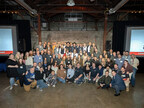DUBLIN, March 7, 2024 /PRNewswire/ — The “Global Hydrogen Hubs Market by Industry (Automotive, Aviation, Marine), Supply Technique (SMR, Electrolysis), End Use (Liquid Hydrogen, Hydrogen Fuel Cell) & Region (North America, Europe, APAC, MEA, & Latin America) – Forecast to 2030″ report has been added to ResearchAndMarkets.com’s offering.
The hydrogen hubs market is valued at USD 1.8 billion in 2023 and is projected to reach USD 5.9 billion by 2030, at a CAGR of 18.6% from 2023 to 2030. The hydrogen hub market is witnessing substantial growth driven by the emergence of vertically integrated hydrogen infrastructure. These facilities, encompassing production, storage, and distribution, optimize the hydrogen supply chain. Increased spending on hydrogen infrastructure further fuels market expansion, positioning hydrogen hubs as pivotal players in the evolving landscape of clean energy solutions.
Based on industry, the automotive segment will register the highest growth during the forecast period
Based on industry, the hydrogen hubs market is segmented into automotive, aviation, marine, and others, which includes defense and space. The automotive industry is expected to be a key demand area for hub based hydrogen as the adoption of fuel cells in mobility continues to accelerate. The automotive segment is expected to grow from USD 1.05 billion in 2023 and is projected to reach USD 3.9 billion by 2030, at a CAGR of 20.6% during the forecast period.
Based on supply technique, the electrolysis segment will register the highest growth during the forecast period
Based on supply technique, the hydrogen hub market is segmented into steam methane reforming (SMR) and electrolysis segments. Of these segments, electrolysis is expected to have the highest growth from USD 1.1 billion in 2023 to USD 3.7 billion in 2030, registering a CAGR of 18.7%. Steam methane reforming (SMR) and electrolysis stand out as the two primary methods for hydrogen production within hydrogen hubs, particularly in the context of blue and green hydrogen.
SMR, commonly associated with blue hydrogen, involves the reaction of natural gas with steam to produce hydrogen and carbon dioxide. Although it is a well-established and cost-effective process, the associated carbon emissions necessitate carbon capture and storage (CCS) for environmental sustainability. On the other hand, electrolysis, linked to green hydrogen, utilizes renewable energy to split water into hydrogen and oxygen. While offering a cleaner alternative, electrolysis faces challenges related to high energy costs and the need for significant renewable energy infrastructure. The choice between these methods reflects the ongoing industry debate regarding trade-offs between cost efficiency and environmental impact in the pursuit of a sustainable hydrogen economy.
Based on end use form, liquid hydrogen and fuel cells are the primary products that hydrogen hubs are expected to produce as more hydrogen hubs are developed
Based in end-use, hydrogen hubs market are segmented into liquid hydrogen and hydrogen fuel cells, which are the primary products from these hubs. Both of these end products – hydrogen fuel cells and liquid hydrogen – have diverse applications within the clean energy sector. Hydrogen fuel cells play a crucial role in powering various transport modes, including automobiles, buses, and trains, as well as providing backup power for industries.
The fuel cells’ efficiency and environmental benefits make them a key driver for the adoption of hydrogen as a clean energy source. Simultaneously, the production of liquid hydrogen is integral for efficient storage and transportation, especially for long-distance supply chains and applications in industries such as aerospace. The strategic integration of these end products from regional hydrogen hubs reflects the comprehensive approach to harnessing hydrogen’s potential across different sectors, contributing to a more sustainable and integrated energy ecosystem.
Based on regions, the Asia Pacific region is estimated to have the highest growth during the forecast period
The Asia Pacific region is estimated to account for the largest share of the hydrogen hubs market in 2023. The growth of the region is attributed to the rapid developments in alternative energy and fuel technologies to wean away from fossil fuel based energy consumption. This is enhanced by the development of renewable energy propulsion systems for automobiles, ships and aviation segments, which are expected to use hydrogen or hydrogen based duel sources as a primary propellant.
Key Topics Covered:
Executive Summary
Electrolysis Segment to Hold Largest Market Share During Forecast PeriodAutomotive to be Fastest-Growing Segment During Forecast PeriodAsia-Pacific to Register Highest CAGR During Forecast Period
Premium Insights
Attractive Opportunities for Players in Hydrogen Hubs Market – Increased Focus on Green and Clean Energy Solutions to Drive MarketHydrogen Hubs Market, by Supply Technique – Electrolysis Segment Dominated Market in 2023Hydrogen Hubs Market, by Industry – Automotive Industry to Lead Market During Forecast Period
Market Dynamics
Drivers
Increasing Vertical Integration of Hydrogen Production FacilitiesRising Public and Private Investments in Hydrogen and Associated Fuel Cell TechnologiesGrowing Development of Regional Green Hydrogen Hubs
Restraints
Infrastructure and Production Limitations
Opportunities
Industrial Transition Toward Green HydrogenWidespread Adoption of Hydrogen-based Mobility
Challenges
High Production Cost and Complex Storage and TransportationLow Power Density of Hydrogen Fuel Cell Stacks
Technology Analysis
ElectrolysisHydrogen Storage TechnologiesCarbon Capture, Utilization, and Storage
Analysis of New Business Models
Automotive Industry: Fuel Cell Stacks and Hydrogen Refueling StationsAviation Industry: Hydrogen Fuel and Fuel Cell-Powered Aircraft
Use Case Analysis
Hamburg Green Hydrogen HubImproved Hydrogen Mobility
Technology Trends
Hydrogen StorageAmmonia Cracking
Impact of Megatrends
ElectrolysisArtificial IntelligenceDecarbonization of Supply Chain and Infrastructure
Innovations and Patent Analysis
Types of Hydrogen Produced at Hub FacilityGreen HydrogenBlue HydrogenOn-Site Infrastructure for Hydrogen HubsHydrogen Conversion EquipmentPrimary Energy Source for Hydrogen Hubs
Companies Profiled
LindeSaudi Arabian Oil GroupShellSinopec Corp.AirbusAir LiquideAir Products and ChemicalsChevron CorporationIwatani CorporationMessers GmbHBgr Energy SystemsUniperGreenstatFuelcell Energy.CumminsBloom Energy GroupPlug PowerElement 1 Corp.Nel HydrogenAw EnergyNproxxGardner CryogenicsCalvera HydrogenHexagon Composites
For more information about this report visit https://www.researchandmarkets.com/r/m8m66i
About ResearchAndMarkets.com
ResearchAndMarkets.com is the world’s leading source for international market research reports and market data. We provide you with the latest data on international and regional markets, key industries, the top companies, new products and the latest trends.
Media Contact:
Research and Markets
Laura Wood, Senior Manager
press@researchandmarkets.com
For E.S.T Office Hours Call +1-917-300-0470
For U.S./CAN Toll Free Call +1-800-526-8630
For GMT Office Hours Call +353-1-416-8900
U.S. Fax: 646-607-1907
Fax (outside U.S.): +353-1-481-1716
Logo: https://mma.prnewswire.com/media/539438/Research_and_Markets_Logo.jpg
View original content:https://www.prnewswire.com/news-releases/global-hydrogen-hubs-market-forecast-to-2030-increased-focus-on-green-and-clean-energy-solutions-to-drive-market-growth-302082650.html
SOURCE Research and Markets

 Near Videos5 days ago
Near Videos5 days ago
 Technology4 days ago
Technology4 days ago
 Technology5 days ago
Technology5 days ago
 Technology4 days ago
Technology4 days ago









